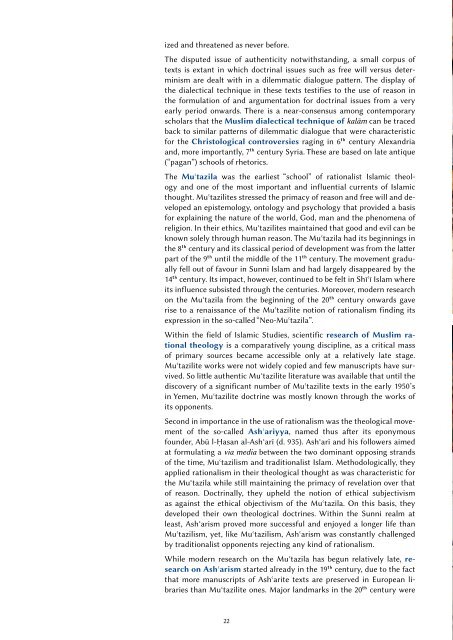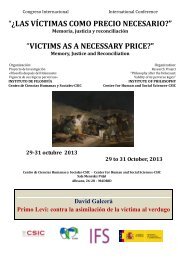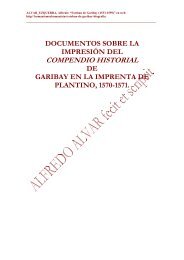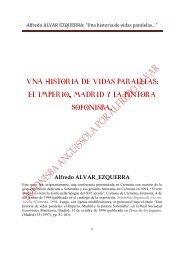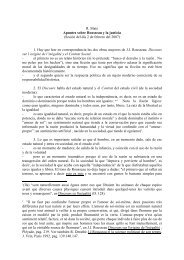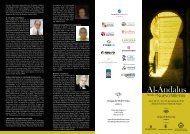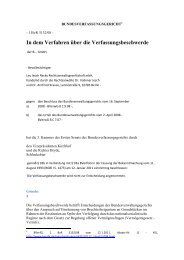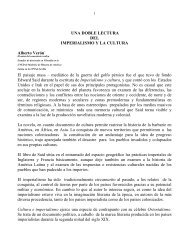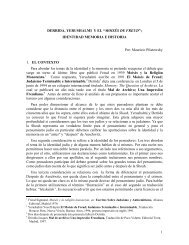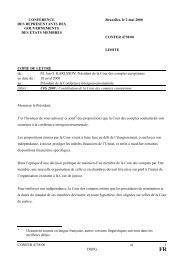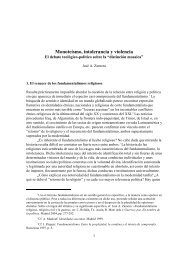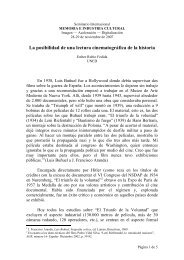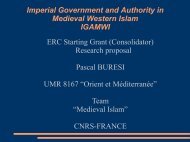brochure 2012 - Consejo Superior de Investigaciones CientÃficas
brochure 2012 - Consejo Superior de Investigaciones CientÃficas
brochure 2012 - Consejo Superior de Investigaciones CientÃficas
You also want an ePaper? Increase the reach of your titles
YUMPU automatically turns print PDFs into web optimized ePapers that Google loves.
ized and threatened as never before.<br />
The disputed issue of authenticity notwithstanding, a small corpus of<br />
texts is extant in which doctrinal issues such as free will versus <strong>de</strong>terminism<br />
are <strong>de</strong>alt with in a dilemmatic dialogue pattern. The display of<br />
the dialectical technique in these texts testifies to the use of reason in<br />
the formulation of and argumentation for doctrinal issues from a very<br />
early period onwards. There is a near-consensus among contemporary<br />
scholars that the Muslim dialectical technique of kalām can be traced<br />
back to similar patterns of dilemmatic dialogue that were characteristic<br />
for the Christological controversies raging in 6th century Alexandria<br />
and, more importantly, 7th century Syria. These are based on late antique<br />
(“pagan”) schools of rhetorics.<br />
The Muʿtazila was the earliest “school” of rationalist Islamic theology<br />
and one of the most important and influential currents of Islamic<br />
thought. Muʿtazilites stressed the primacy of reason and free will and <strong>de</strong>veloped<br />
an epistemology, ontology and psychology that provi<strong>de</strong>d a basis<br />
for explaining the nature of the world, God, man and the phenomena of<br />
religion. In their ethics, Muʿtazilites maintained that good and evil can be<br />
known solely through human reason. The Muʿtazila had its beginnings in<br />
the 8th century and its classical period of <strong>de</strong>velopment was from the latter<br />
part of the 9th until the middle of the 11th century. The movement gradually<br />
fell out of favour in Sunni Islam and had largely disappeared by the<br />
14th century. Its impact, however, continued to be felt in Shīʿī Islam where<br />
its influence subsisted through the centuries. Moreover, mo<strong>de</strong>rn research<br />
on the Muʿtazila from the beginning of the 20th century onwards gave<br />
rise to a renaissance of the Muʿtazilite notion of rationalism finding its<br />
expression in the so-called “Neo-Muʿtazila”.<br />
Within the field of Islamic Studies, scientific research of Muslim rational<br />
theology is a comparatively young discipline, as a critical mass<br />
of primary sources became accessible only at a relatively late stage.<br />
Muʿtazilite works were not wi<strong>de</strong>ly copied and few manuscripts have survived.<br />
So little authentic Muʿtazilite literature was available that until the<br />
discovery of a significant number of Muʿtazilite texts in the early 1950’s<br />
in Yemen, Muʿtazilite doctrine was mostly known through the works of<br />
its opponents.<br />
Second in importance in the use of rationalism was the theological movement<br />
of the so-called Ashʿariyya, named thus after its eponymous<br />
foun<strong>de</strong>r, Abū l-Ḥasan al-Ashʿarī (d. 935). Ashʿarī and his followers aimed<br />
at formulating a via media between the two dominant opposing strands<br />
of the time, Muʿtazilism and traditionalist Islam. Methodologically, they<br />
applied rationalism in their theological thought as was characteristic for<br />
the Muʿtazila while still maintaining the primacy of revelation over that<br />
of reason. Doctrinally, they upheld the notion of ethical subjectivism<br />
as against the ethical objectivism of the Muʿtazila. On this basis, they<br />
<strong>de</strong>veloped their own theological doctrines. Within the Sunni realm at<br />
least, Ashʿarism proved more successful and enjoyed a longer life than<br />
Muʿtazilism, yet, like Muʿtazilism, Ashʿarism was constantly challenged<br />
by traditionalist opponents rejecting any kind of rationalism.<br />
While mo<strong>de</strong>rn research on the Muʿtazila has begun relatively late, research<br />
on Ashʿarism started already in the 19th century, due to the fact<br />
that more manuscripts of Ashʿarite texts are preserved in European libraries<br />
than Muʿtazilite ones. Major landmarks in the 20th century were<br />
22 23


